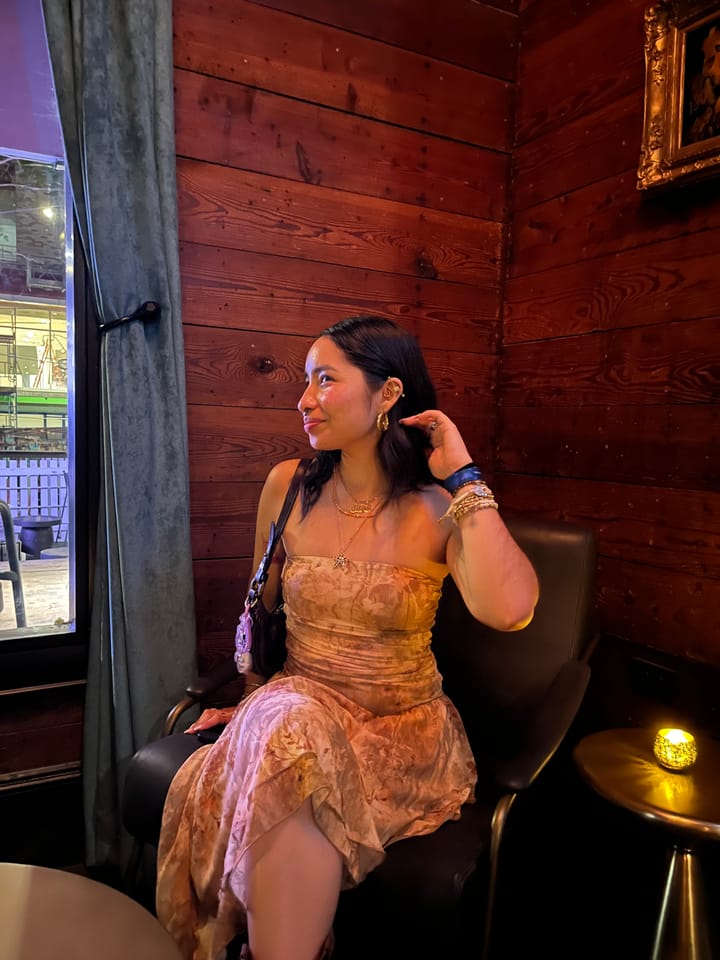Amherst Cinema Screens Works of French Filmmaker Agnes Varda

For the past two months, Amherst Cinema has been holding screenings of the works of Agnes Varda, a French filmmaker whose movies were released in the mid-20th century. Varda made inimitable contributions to the amorphous category of films we nowadays label “arthouse cinema,” and with the final screening of “Beaches of Agnes” on Oct. 30, it may be useful to track Varda’s life and works to answer how and why she more than merits her place in our local theater.
Varda did not begin her artistic life as a filmmaker, but rather as a photographer. One could claim that her arrival onto the cinematic scene paralleled the process by which photos become film: after years of taking countless pictures for a living, it was a matter of time before she imagined them in fluid, vigorous connection.
No other film in her catalogue best confronts this transition than “Cleo From 5 to 7,” the first screening at Amherst Cinema and the film that declared Varda an essential auteur of the emerging medium. “Cleo” follows Cleo (Corinne Marchand), a young singer who is awaiting the results of a cancer test, in real time.
The two hours during which she is waiting, from 5 to 7 p.m., derail her normal daily routine; it is a confrontation with mortality. The film’s escalation around 6 o’clock intimates in a louder and louder voice that the young woman’s future is unsteady.
The concept of real time is a warring synthesis of Varda’s twin arts: photography’s desperation to hold onto a moment out of time and cinema’s unshakeable premise that time and image must flow — minutes into hours, 24 frames per second. In its darkest moments, “Cleo” is a work that despairs over its cinematic qualities and yearns to return to the state of photography. Faced with cancer, Cleo attempts to seize and freeze each moment of her shortened life, but her hours pass without mercy.
Yet, for all this seeming nihilism, “Cleo” ends with a moving deliverance of sorts. This article will not delve into spoilers, but then again it does not need to — the emotions are located less in the story than Varda’s telling of it. By the end, Cleo learns to let go of her photographic desires and accept the flow of cinema. The flipside of the cinematic premise that time will not stop for anything is that it will not stop even for death: life extends beyond 5 o’clock and 6 o’clock and 7 o’clock.
It’s an appropriately existential coda for a French film released in the 1960s that cleverly embodied philosophy in art and established Varda as a formidable voice in the medium. Simply put, she had stuff to say, and the pictures to say them with.
Of course, as accomplished a thinker as she is, Varda is not simply a cold formalist. One of the most prominent woman filmmakers to arise during the era, Varda — out of both interest and inevitability — entered the feminist conversation in the visual arts. Some films like “Le Bonheur,” the story of a fake ally, who through surprisingly funny and miserable ends masks his infidelity as enlightened sexuality, veer close to modern currents of campus discussion.
Other films like “Vagabond,” however, put forth a more idiosyncratic, demanding vision of solidarity. The eponymous vagabond names herself rather quickly, but the revelation is not a triumph of self-identification in a cruel world; in the film, the latter consistently overpowers the former. The movie begins with the vagabond Mona dead in a cold ditch, and rest of the film, following her throughout the city, ensues under the shadow of this fatalism.
In the process, the audience is made aware that the problems of this society cannot be overcome solely through good intentions in isolation. So many of the film’s non-vagabonds suffer from problems — poverty, misogyny, neglect — yet they are united in their derision of the protagonist, who out of hurt or habit never relents in presenting herself in the coarsest and most obnoxious way possible.
Few films clarify the sheer labor of empathy like “Vagabond,” and this is an accomplishment that contextualizes the deceptive simplicity of works like “Le Bonheur,” in which a disarmingly earnest husband does all in his power to ease the audience’s empathy towards him. As a double feature, the two films attack the audience with an uncomfortable situation in which empathy for the cheating husband is easier than for the starving girl. As such, the pair reminds us of the hard, collaborative work necessary to pick the gendered locks of the conscience.
Yet even here, Varda is biographical. As much as she emerged in cinema as a photographer, she emerged as a woman among men, and the work of empathy she demands of the audience corresponds to the incredible hard work she endured to make these films in the first place. What is so refreshing in her capacities as both a formalist and a feminist is the same self-referential egoism that allows her work to subtly arc back to her own life and personality. Around Varda’s time, much hullabaloo was made over the figure of the auteur, an overriding singular individual that obviously announced the accomplishment behind their work.
Her films fit and expand this mold. “Vagabond,” as a film about a neglected woman that emphasizes the audience’s difficulty in empathy, quietly refers to Varda’s own rarefied position in cinema and the difficulty for female artists to hold onto the public’s attention. It is a work that fulfills the standards of an accomplished artist, but also announces not only the presence of the auteur but also the systematic difficulty of that presence.
In so doing, Varda simultaneously critiques her colleagues and celebrates her hard-won place in the medium. What’s more, as is evident in “Cleo,” she makes it clear that her engagement in the timely does not detract from her timelessness.
The photographer became a filmmaker, and if “Cleo” is right in depicting that film can overcome our photographic urges to trap time and shatter the temporal restrictions of existence, Varda has essentially made a film arguing for her newfound immortality.
This is the egoism that defines Varda. In the end, her films about other people speak of how she is the one who needs the rare empathy from her audience — she deserves to last. And in turn, these biographical elements loop back into the fiction: she is Mona the vagabond, she is Cleo the patient.
In so doing, all her feature-length films can be said to contain three cuts: the character to Varda, Varda to the character and finally the character to the audience. For all her cleverness, the crux of her filmmaking is simple and invigorating. Hers is a filmography that on the surface directs itself toward the auteurs and the sophisticated cinephiles of the world, yet ultimately turns its attention to the patients and the vagabonds, those who need this unshakeable sense of the self in uncertain times.
If you count yourself among this group of people or if you are simply in need for a good time at the movies, the screenings of Varda’s works at Amherst Cinema are wonderful opportunities to catch the master on the big screen. Hooray for Mona, from city to ditch. Hooray for Cleo, 5 to 7. Hooray for Agnes, now to forever.





Comments ()